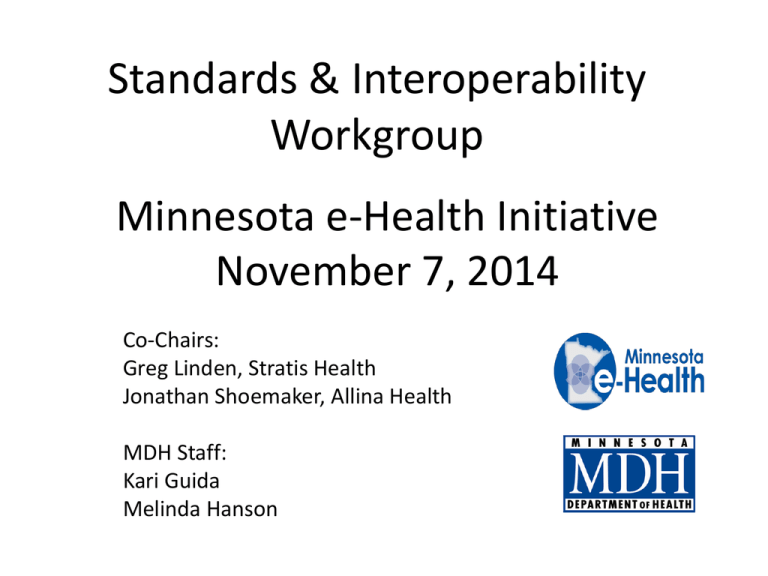
Standards & Interoperability
Workgroup
Minnesota e-Health Initiative
November 7, 2014
Co-Chairs:
Greg Linden, Stratis Health
Jonathan Shoemaker, Allina Health
MDH Staff:
Kari Guida
Melinda Hanson
Meeting Objectives
• Review the workgroup charge
• Discuss the Health Care Quality Measures Study: eHealth Component
• Provide Feedback on Social Determinants of Health
and EHRs
– Capability of EHRs to capture disability, race, ethnicity,
language, and other sociodemographic factors health
– Capacity of EHRs to capture disability, race, ethnicity,
language, and other sociodemographic factors
– Challenges to using disability, race, ethnicity, language, and
other sociodemographic factors collected in the EHRs
2
Agenda
•
•
•
•
Welcome & Introductions
Workgroup Charter
Advancing Health Equity
Health Care Quality Measures Study: e-Health
Component
• Social Determinants of Health & EHRs Panel
• Discussion
• Next Steps & Adjourn
3
Welcome & Introduction
• Name
• Position & Organization
• Estimated number of MN e-Health Initiative
Workgroup meetings attended
4
STANDARDS & INTEROPERABILITY
WORKGROUP CHARGE
5
Workgroup Charge
• Identify gaps, barriers, and opportunities related to capturing
standardized social determinants of health data elements
• Review and recommend nationally recognized standards,
interoperability requirements, implementation specifications
and certification
• Communicate information on adoption of standards,
implementation specifications and certification criteria
related to the requirements of “meaningful use” and
Minnesota 2015 interoperable EHR mandate, and recommend
resources and actions that will help increase implementation
of these standards (e.g., Minnesota e-Health Standards and
Interoperability Guide).
6
ADVANCING HEALTH EQUITY
7
Advancing Health Equity in Minnesota:
Report to the Legislature (2014)
• Initiated because disparities in health status
outcomes for certain populations are
continuing unabated, including disparities
based on race or ethnicity
• Assesses Minnesota’s health disparities and
health inequities and recommends best
practices, policies, process, data strategies and
other steps to promote health quality
8
Health Disparities & Health inequities
in Minnesota
•
•
•
•
•
•
African American and American Indian babies die in the first year of life at twice
the rate of white babies.
Gay, lesbian and bisexual university students are more likely than their
heterosexual peers to have struggles with their mental health.
Intimate partner violence affects 11 to 24 percent of high school seniors, with the
highest rates among American Indian, African American and Hispanic/Latino
students. American Indian, Hispanic/Latino, and African American youth have the
highest rates of obesity.
Persons with serious and persistent mental illness die, on average, 25 years earlier
than the general public.
African American and Hispanic/Latino women in Minnesota are more likely to be
diagnosed with later-stage breast cancer.
Nearly 25 percent of persons in Minnesota over 50 who live alone have no one to
provide care for them if they were to become sick or disabled, compared to only
five percent of those who live with others.
Advancing Health Equity in Minnesota: Report to the Legislature (2014)
9
Health Equity Terminology (1 of 3)
•
Health is a state of complete physical, social and mental well-being and not merely the
absence of disease or infirmity (WHO).
•
Health disparity: A population-based difference in health outcomes (e.g., women have more
breast cancer than men).
•
Health inequity: A health disparity based in inequitable, socially-determined circumstances
(for example, American Indians have higher rates of diabetes due to the disruption of their
way of life and replacement of traditional foods with unhealthy commodity foods). Because
health inequities are socially-determined, change is possible. Socially determined means that
these conditions are created by decisions that affect community or society at large (e.g.
polices of governments, corporate decisions, neighborhood action)
•
Health equity: When every person has the opportunity to realize their health potential — the
highest level of health possible for that person — without limits imposed by structural
inequities. Health equity means achieving the conditions in which all people have the
opportunity to attain their highest possible level of health.
Advancing Health Equity in Minnesota: Report to the Legislature (2014)
10
Health Equity Terminology (2 of 3)
• Population Health: An aim to optimize the health and well-being of an
entire community and reduce inequalities in health and well-being
between population groups. A “community” may be either geographic
regions and/or groups of people who share attributes (e.g., elderly,
minorities, employees, disabled persons, students). Population health
requires collaboration across all sectors of a community to address factors
such as public infrastructure, the environment, education systems, social
supports, and the health care system, in order to address all social
determinants of health. Population health within an accountable care
organization requires collaboration between all health care providers in
the community, social support services within the community, and local
public health.
Adapted from:
•
K Hacker, DK Walker. Achieving Population Health in Accountable Care Organizations, Am J Public Health.
2013; 103(7):1163-1167. D Kindig, G Stoddart. What is population health? Am J Public Health.
2003;93(3):380–383; and
•
M Stoto. Population Health in the Affordable Care Act Era. AcademyHealth, February 2013.
11
Health Equity Terminology (3 of 3)
• Social Determinants of Health are the complex, integrated, and
overlapping social structures and economic systems that are
responsible for most health inequities. These social structures and
economic systems include the social environment, physical
environment, health services, and structural and societal factors.
Social determinants of health are shaped by the distribution of
money, power, and resources throughout local communities,
nations, and the world.
Commission on Social Determinants of Health, Closing the gap in a generation: health
equity through action on the social determinants of health. Final report of the
Commission on Social Determinants of Health. 2008, World Health Organization:
Geneva.
12
Summary of Selected and Non-Selected
Domains (1 of 2)
Candidate Set of Domains for Consideration for the Inclusion
in all Electronic Health Records
Sociodemographic Domains
Sexual orientation
Race/ethnicity
Country of origin/U.S. born or non-U.S. born
Education
Employment
Financial resource strain (Food and housing insecurity)
Psychological Domains
Health literacy
Stress
Negative mood and affect (Depression, anxiety)
Psychological assets (Conscientiousness, patient
engagement/activation, optimism, self-efficacy)
Behavioral Domains
Dietary patterns
Physical activity
Nicotine use and exposure
Alcohol use
Domains Reviewed But Not Selected
Sociodemographic Domains
Gender identity
Psychological Domains
Negative mood and affect (Hostility and anger,
hopelessness)
Cognitive function in late life
Positive psychological function (Coping, positive affect,
life satisfaction)
Behavioral Domains
Abuse of other substances
Sexual practices
Exposure to firearms
Risk-taking behaviors (Distractive driving and helmet use)
Capturing Social and Behavioral Health Domains in Electronic Health Records: Phase 1. Committee on the Recommended Social and Behavioral
Domains and Measures for Electronic Health Records; Board on Population Health and Public Health Practice; Institute of Medicine (2014) 13
Summary of Selected and Non-Selected
Domains (2 of 2)
Candidate Set of Domains for Consideration for the
Inclusion in all Electronic Health Records
Individual-Level Social Relationships Domains
Social connections and social isolation
Exposure to violence
Neighborhoods and Communities (Geocodable Domains)
Socioeconomic characteristics
Race/ethnic characteristics
Domains Reviewed But Not Selected
Individual-Level Social Relationships Domains
Social Support (Emotional, instrumental, and other)
Work conditions
History of incarceration
Military service
Community and cultural norms (Health care decision
making)
Neighborhoods and Communities (Geocodable Domains)
Environmental exposures (Air pollution, allergens,
other hazardous exposures)
Neighborhood resources (Nutritious food options,
transportation, parks, open spaces, health care and
social services, educational and job opportunities )
Capturing Social and Behavioral Health Domains in Electronic Health Records: Phase 1. Committee on the Recommended Social
and Behavioral Domains and Measures for Electronic Health Records; Board on Population Health and Public Health Practice;
Institute of Medicine (2014)
14
HEALTH CARE QUALITY MEASURES
STUDY: E-HEALTH COMPONENT
15
Health Care Quality Measure Study:
e-Health Component
• Plan for stratifying health care quality measures based
on disability, race, ethnicity, language, and other
sociodemographic factors to the Legislature by January
15, 2015
• To identify the status, barriers, and opportunities in
using electronic health records (EHRs) to collect social
determinants of health and to understand challenges in
using social determinants of health data.
• Make recommendations for needed future work,
studies, and resources needed to leverage EHRs as a
tool to achieve health equity.
• Focused on quality measures for clinics and hospitals
but all providers across the spectrum of care can
benefit from this work
16
e-Health Questions
The Office of Health Information Technology (OHIT) along with
engagement of the MN e-Health Initiative will start to answer
three questions:
• What is the capability of EHRs to capture disability, race,
ethnicity, language, and other socio-demographic factors?
• What is the capacity of EHRs to capture disability, race,
ethnicity, language, and other socio-demographic factors?
• What are the challenges to using disability, race, ethnicity,
language, and other socio-demographic factors collected in
the EHRs?
17
Methods
• Evaluate current assessment data collected on clinics and
hospitals and social determinants of health factors from the
MN e-Health Profile
• Review and leverage current reports such as
– Capturing Social and Behavioral Domains in Electronic Health
Records Phase 1 & Phase 2 Reports
– Advancing Health Equity in Minnesota: Report to the Legislature
• Document how Meaningful Use Stage 2 currently requires
and has standards for social determinants of health
• Stakeholder engagement and expert opinion
– Standards & Interoperability Workgroup Meeting
– Requesting feedback on the three questions
18
Timeframe
• Send additional thoughts to
Kari.guida@state.mn.us by November 11.
• Preliminary findings reviewed by workgroup
between November 20 –December 2.
• MN e-Health Advisory Committee reviews the
workgroup findings on December 9.
19
Meaningful Use & Social Determinants of Health
Stage 2 Eligible Professional
Meaningful Use Core Measures
Measure 3: Record Demographics
• Objective: Record the following demographics:
preferred language, sex, race, ethnicity, date
of birth
• Measure: More than 80 percent of all unique
patients seen by EP have demographics
recorded as structured data
20
Percent of Minnesota clinics with EHRs
capturing demographic information on 80% or
more of their patients (2014)
Data source: Minnesota Department of Health, Office of Health Information Technology, 2014
Health Information Technology Survey.
21
Percent of MN clinics with EHRs capturing
detailed race and ethnicity information in
the EHR (2014)
Data source: Minnesota Department of Health, Office of Health Information Technology, 2014
Health Information Technology Survey.
22
SOCIAL DETERMINANTS OF HEALTH
AND EHRs PANEL
23
Panelists
•
•
•
•
Kevin Larsen, Office of the National Coordinator
Nancy Garret, Hennepin County Medical Center
Bjorn Westgard, Regions Hospital, HealthPartners
Kevin Peterson, Phalen Village Clinic
24
Questions
• What is the capability of EHRs to capture
disability, race, ethnicity, language, and other
socio-demographic factors?
• What is the capacity of EHRs to capture
disability, race, ethnicity, language, and other
socio-demographic factors?
• What are the challenges to using disability,
race, ethnicity, language, and other sociodemographic factors collected in the EHRs?
25
Disparities Data and the EHR
Bjørn C. Westgard, MD, MA, FACEP
Regions Hospital - HealthPartners Medical Group
Hennepin County Medical Center
Assistant Professor, University of MN Medical School
What is the capability of EHRs to capture
disability, race, ethnicity, language,
and other socio-demographic factors? (1 of 2)
• What is captured – race, ethnicity,
employment?
• Where is it captured (notes or structured)?
– Self-reported race/ethnicity – structured
demographic
– Country of origin – structured demographic
– Primary language – structured demographic
– Employment – social history notes
– Disability – notes
What is the capability of EHRs to capture
disability, race, ethnicity, language, and other
socio-demographic factors? (2 of 2)
• What standards are used?
– Census categories plus
– Site based EPIC dictionary
• Common to hospitals, clinics, health plans
– Variable quality continuity
– Continual training and process improvement
28
How much/what percent of
patients have the information
complete in the EHR?
• Race/ethnicity
– Previously 70-80%
– EBAN Disparities-Oriented QI/PI Project
– Up in 90% range presently
• Country of origin and language
– Up in 90% range presently
– Closer to 60% completion
• Other data – variable
What are the challenges to using disability,
race, ethnicity, language, and other
socio-demographic factors collected in the EHRs?
(1 of 2)
• Defining the use for this data
– Question determines relevant data
– Interoperability needs
• Clinical elements
– Operationally-relevant disparities goals
– Clinically-relevant disparities information
– Clinical uncertainty and provider discretion
What are the challenges to using disability,
race, ethnicity, language, and other
socio-demographic factors collected in the EHRs?
(2 of 2)
Data elements
•
•
•
•
Consistent capture of data variables
Uniform coding of data variables
Usable, non-obstructing interface for end users
Relevant, validated data
– Place and space
– Measures of socioeconomic status
• Real standards of interoperability
• Legal framework or mandate for interoperability
DISCUSSION ON SOCIAL
DETERMINANTS OF HEALTH AND EHRs
32
Next Steps
• Send additional thoughts to Kari.guida@state.mn.us by
Tuesday, November 11th.
• Preliminary findings reviewed by workgroup between
November 20 –December 2
• MN e-Health Advisory Committee endorses workgroup
findings December 9
• Full legislative report will be available in Winter 2015
• Watch for details about next Standards &
Interoperability meeting in February 2015
• Save the Date: Minnesota e-Health Summit June 16 17, 2015 (Tentative)
33
Resources
• Advancing Health Equity in Minnesota: Report to the Legislature (2014)
– http://www.health.state.mn.us/divs/chs/healthequity/index.htm
• Capturing Social and Behavioral Domains in Electronic Health Records:
Phase 1
– http://www.iom.edu/reports/2014/capturing-social-and-behavioraldomains-in-electronic-health-records-phase-1.aspx
• Risk Adjustment for Socioeconomic Status or Other Sociodemographic
Factors (2014)
– http://www.qualityforum.org/Publications/2014/08/Risk_Adjustment_for
_Socioeconomic_Status_or_Other_Sociodemographic_Factors.aspx
• Commission on Social Determinants of Health, Closing the gap in a
generation: health equity through action on the social determinants of
health. Final report of the Commission on Social Determinants of
Health. 2008, World Health Organization: Geneva
– http://www.who.int/social_determinants/thecommission/finalreport/en/
34
Standards & Interoperability
Workgroup Leadership
Greg Linden, Co-Chair
Vice President, Information Services/Chief Information Officer
Stratis Health
Jonathan Shoemaker, Cho-Chair
Director, Information Services
Allina Health
Kari Guida, MDH Workgroup Coordinators
MDH Office of Health Information Technology
kari.guida@state.mn.us
Melinda Hanson, MDH Workgroup Coordinators
MDH Office of Health Information Technology
melinda.hanson@state.mn.us
35
Health Care Quality Measure Study (1 of 3)
Minnesota Laws, Chapter 312, Article 23, Section 10
(a) The commissioner of health shall develop an
implementation plan for stratifying measures based on
disability, race, ethnicity, language, and other
sociodemographic factors that are correlated with health
disparities and impact performance on quality measures. The
plan must be designed so that quality measures can be
stratified beginning January 1, 2017, in order to advance work
aimed at identifying and eliminating health disparities. By
January 15, 2015, the commissioner shall submit a report to
the chairs and ranking minority members of the senate and
house of representatives committees and divisions with
jurisdiction on health and human services and finance with
the plan, including an estimated budget, timeline, and
processes to be used for implementation.
36
Health Care Quality Measure Study (2 of 3)
Minnesota Laws, Chapter 312, Article 23, Section 10
(b) The commissioner of health shall assess the risk
adjustment methodology established under Minnesota
Statutes, section 62U.02, subdivision 3, for the potential for
harm and unintended consequences for patient populations
who experience health disparities, and the providers who
serve them, and identify changes that may be needed to
alleviate harm and unintended consequences. By January 15,
2016, the commissioner shall submit a report to the chairs
and ranking minority members of the senate and house of
representatives committees and divisions with jurisdiction on
health and human services and finance with the result of the
assessment of the risk-adjustment methodology and any
recommended changes.
37
Health Care Quality Measure Study (3 of 3)
Minnesota Laws, Chapter 312, Article 23, Section 10
(c) The commissioner shall develop the plan described in
paragraph (a), in consultation with consumer, community and
advocacy organizations representing diverse communities;
health plan companies; providers; quality measurement
organizations; and safety net providers that primarily serve
communities and patient populations with health disparities.
The commissioner shall use culturally appropriate methods of
consultation and engagement with consumer and advocacy
organizations led by and representing diverse communities by
race, ethnicity, language, and sociodemographic factors.
38










